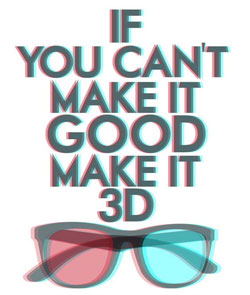Harry Potter’s 3D Dilemma
The recent release of the 8th Harry Potter movie, Harry Potter and the Deathly Hallows: Part 2, by all accounts, is a huge success. It set both a one-day and an opening weekend record. In fact, it blew by its estimated $125 million cost to make the movie within 37 hours of release.
And, about 35 percent of those seeing the latest Harry Potter adventure are seeing it in 3D – whether they liked it or not, if they wanted a seat opening weekend.
Once upon a time, the philosophy in the movie industry was, “If you can’t make it good, make it 3D” — and that applied in the 1980s and 1990s to all sorts of B movies like the Friday the 13th series (#3 in particular), Jaws 3D (the one that barely gets claimed by the series creator – see Wikipedia’s details: http://en.wikipedia.org/wiki/Jaws_3-D), Amityville 3D and Into the Deep.
And, as we all know, there’s a movement to do more and more 3D as a way to differentiate the movie theater experience. All the while, the consumer electronics manufacturers are also pushing 3D in the home.
The ‘in the home’ part of it is what I have a real problem with. Less than 5 percent of the U.S. population can truly appreciate 3D for one simple reason – their screen is just too small. You really need to immerse your entire visual realm in the experience to appreciate 3D in a way that is worth the hassle of wearing the glasses, dealing with the nearly 50 percent reduction in light output and the obvious focus issues. Thus, an in-home experience just doesn’t cut it and gives good, quality 3D a bad name.
 Which brings me back to Harry Potter and the Deathly Hallows: Part 2. That 3D simply sucked. Why bother? What an amazing movie to have force-fed a few scenes to the audience in 3D. And, in fact, according to Popular Mechanics (http://www.popularmechanics.com/technology/digital/3d/the-5-toughest-3D-conversions-in-harry-potter-and-the-deathly-hallows-part-2) only one scene in the entire movie was specifically designed to be shot in 3D.
Which brings me back to Harry Potter and the Deathly Hallows: Part 2. That 3D simply sucked. Why bother? What an amazing movie to have force-fed a few scenes to the audience in 3D. And, in fact, according to Popular Mechanics (http://www.popularmechanics.com/technology/digital/3d/the-5-toughest-3D-conversions-in-harry-potter-and-the-deathly-hallows-part-2) only one scene in the entire movie was specifically designed to be shot in 3D.
So, why bother? Marketing hype, plus the fact that the increased sales from higher 3D theater ticket prices allowed the movie to break all previous revenue records quite easily.
But, the sad truth here is that the lack of real 3D (it was a movie converted to 3D in post-production) is actually detracting from the movie’s success. It’s not a showcase for what real 3D can be like and they would have done just as much business with the movie in 2D as they did in 3D – except the people who saw it in 3D first, complained that it didn’t look that great in 3D and went back to see it in 2D later (like my daughter).
Why would people like IMAX, Warner Brothers and Harry Potter director David Yates allow this?
Google the movie and you’ll see that virtually all the negative discussion or conversation online regarding Harry Potter’s 8th movie is over the crappy 3D. Not the plot, not the computer animation, not the lack of realism in the special effects, not the character flaws, not the lines the movie-going public had to endure during one of the hottest weekends on record in the eastern part of the U.S. – it was the bad 3D experience.
My only hope is that this has taught Hollywood a lesson and will be one that is closely followed by the entire HDTV market as a warning that just because you can do it, doesn’t mean you should do it.
 Instead of spending time and R&D on 3D in the home — which I can promise will be a miserable failure; all you have to do is go online and read what real, 3DTV owners are saying about their TVs (once they actually see a 3D movie in their home) in forums, discussions, Facebook and Twitter. They want the new technology to do a better job integrating the Web into TVs.
Instead of spending time and R&D on 3D in the home — which I can promise will be a miserable failure; all you have to do is go online and read what real, 3DTV owners are saying about their TVs (once they actually see a 3D movie in their home) in forums, discussions, Facebook and Twitter. They want the new technology to do a better job integrating the Web into TVs.
And, not GoogleTVish Web. People want TV when they want it, how they want it and in a way that’s easy to use. And, they’ll pay for it – at a much higher rate (and as recurring revenue) annually than 3D movies. Give us better content than what Netflix WatchNow, a user interface experience more like AppleTV, HD quality more like VUDU, wireless connectivity and integration more like Samsung’s Smart TV and access to theatrical releases quicker — even if you’ve got to charge $50 or $100. We’ll pay it. It still cheaper, and more comfortable than going to a movie when you add in concessions, a babysitter and the tickets.
Don’t believe me? Well, just ask your fans. Ask the movie going public. The box-office buyers. Or, you can just keep doing what you’re doing now and develop and integrate new technology and services in a padded box somewhere in consumer-TV-manufacturing land and not pay attention to all the stuff being said in social media about how 3D sucks and how those same people left the Harry Potter movie, tweeting about how good it was and then went home to stream the latest episode of “Modern Family” off Hulu.



